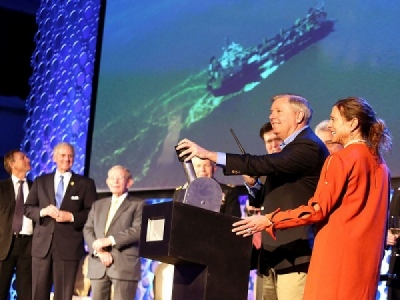
Posted on March 5, 2018
By David Wren, The Post and Courier
U.S. Sen. Lindsey Graham wants to change the way big-ticket maritime projects are funded after the Charleston Harbor deepening was omitted from the president’s budget for the next fiscal year.
“My No. 1 priority for 2018 is to change the formula” for federal funding, the South Carolina Republican said Friday during a harbor deepening ceremony in Mount Pleasant featuring politicians, champagne and confetti cannons. The event marks the official start of digging Charleston’s shipping channel to 52 feet from its current 45-foot depth.
The $529 million project, which will let some of the world’s biggest container ships visit the Port of Charleston even at low tide, is funded in large part by $300 million that South Carolina legislators banked years ago.
While that lines up with President Donald Trump’s mandate that federal dollars should go toward infrastructure initiatives with a local match, the state’s contribution was not factored into a budget formula that gauges a project’s overall public benefit against its cost.
That put Charleston far behind a similar dredging effort in Savannah — which would get $49 million under Trump’s new spending plan — and other projects nationwide on the priority list.
“I’m disappointed, frankly, in the Trump budget because it didn’t include us,” Graham said.
The budget formula — called a cost-benefit ratio — is actually a recommendation the Army Corps of Engineers makes when submitting projects to Congress for federal funding. The Office of Management and Budget then runs that recommendation through its own analysis to come up with the figure that’s included in the president’s budget.
“We are not privy to how OMB reaches their final conclusion,” said Glenn Jeffries, spokeswoman for the Army Corps office in Charleston.
Graham said he wants states and localities to get credit for the money they put up when federal budget writers run their numbers. He hopes to codify an updated formula in time for next year’s budget.
“When you change the formula, you can have the money flow a lot faster,” Graham said,.
Jim Newsome, CEO of the State Ports Authority, said the project needs $90 million a year from the federal government to keep the dredging project on schedule for a three-year completion. The Army Corps estimates dredging could take longer — between 40 and 76 months, depending on weather, equipment availability and other factors.
Regardless of the timeline, Gov. Henry McMaster said the federal government must start addressing Charleston’s needs today. McMaster, who is running to stay in office, said he plans to speak with Trump, a close political ally, about getting a steady flow of money.
“If the facts and circumstances are known, such as the value of this port and the fact that South Carolina has already put up 300 million of its own dollars, given the right analysis under the right formula we’ll receive the money from the federal budget,” he said.
In the meantime, Graham said about $25 million could be available for the Charleston deepening from a separate Army Corps fund he helped to create about five years ago. That money could be added to $17.5 million the project received from the Army Corps last year.
The dredging project will give the Port of Charleston the deepest waterway on the East Coast as a greater number of container ships from Asia are visiting South Atlantic seaports through the expanded Panama Canal. Charleston already has regular calls from ships carrying up to 14,000 cargo boxes and Newsome said a vessel capable of hauling 18,000 containers will visit by the end of this year.
The Army Corps last fall awarded two contracts to Oak Brook, Ill.-based Great Lakes Dredge & Dock.
The first, for $47 million, is to remove 6 million cubic yards of material from the harbor’s entrance channel. The second — at $213 million it was the largest awarded by the local Army Corps office — is to remove nearly 8 million cubic yards of material from the entrance channel.
Friday’s ceremony aboard the USS Yorktown at Patriots Point was to celebrate what Newsome calls “the beginning of the end” of a long process to deepen Charleston Harbor.
The project began in 2011 when an Army Corps study determined there is federal interest in deepening the harbor. It has progressed more quickly than any federal deepening project to date. Congress authorized the deepening in late 2016 and dredging officially started Friday.
The project is among more than $2 billion being spent in and around the Port of Charleston to accommodate the heavier container ships.
Source: The Post and Courier





